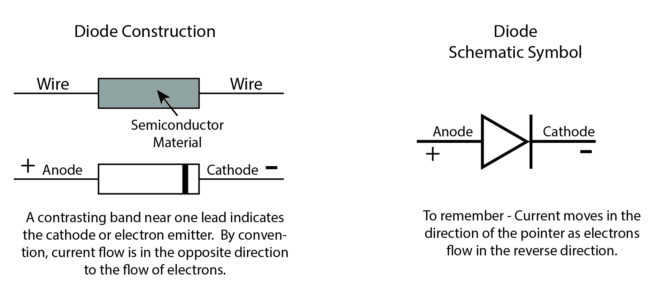The purpose of a diode is to allow the flow of electrical current in only one direction. The ability to control current flow is very useful in electronics applications. Diodes have been around in one form or another for a long time. In the days of vacuum tubes, a “diode” was a tube with a heated cathode and an adjacent or surrounding plate (electron receptor) called an anode. The cathode was heated by a filament to produce electrons that could only flow from the cathode to the anode (not vice versa).
The semiconductor diode was the very first semiconductor device. Today, the diode, with subsequent means to control its conductivity in a variety of ways, gave way to the transistor and nearly all of our semiconductor devices. But, for today, let’s just limit it to the basic diode.
Because it can be very confusing, here is a little diagram that I keep in my wallet.

One of the primary uses for diodes in electronic circuits today is rectification. If a diode is placed in series with a sine wave voltage source, the diode rejects the negative portion of the sine wave to produce what is called half wave rectification. In a little more clever arrangement, 4 diodes can be used to flip the negative portion of the sine wave positive to produce what is called full wave rectification.

The benefit to full wave rectification in the case of power supplies is that it is more efficient because the negative half of the sine wave is not discarded.
Note – Half wave rectification is sometimes used in simple “off/dim/full” light dimmers used in homes. The switch simply connects a single diode in series with the load for half brightness.
Diodes are rated based on their ability to tolerate reverse voltage and their capability to conduct in the conducting mode.
There are many variations of diodes available today. These include light sensitive diodes that conduct when photons are present, diodes that emit photons as light, and diodes which conduct only up to a desired voltage.
– JF –



 English
English Spanish
Spanish Chinese
Chinese Canada
Canada Mexico
Mexico United Kingdom
United Kingdom



